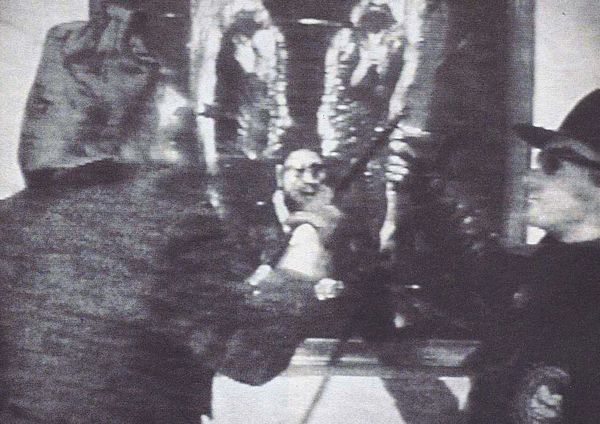museum collecting | 1991
Zodiac 6 |
1. I presented partial versions of this paper to the World Federation of Friends of Museums at their Cordoba meeting in April 1990, and to the Society of Architectural Historians, Southeastem Chapter meeting in Atlanta Georgia, in
October 1990. It needs to be stated at once that my account of recent American museum building is highly partial and admittedly partisan. Not only are the examples clamoring for inclusion far too numerous: they are also too diverse to fall in line with the broad strokes with which I have drawn my picture. As a matter of fact, entire firms, e.g. Edward L. Barnes, Hardy/Holzman/Pfeiffer, Charles Moore, or Venturi, Scott Brown and Associates, have been left out of consideration altogether. With regard to Venturi, see e.g. S. Von Moos "Body Language and Artifice", in a+u, 237, 1990, 6, pp. 121-130. Instead of comprehensive coverage and impartial views, I altempt to give an analytical assessment of only those projects and interventions that have brought new ideas to bear on the course of the museum's transformation in recent years.
|
Among basic building types, museums are newcomers, only a little older than railroad stations, but much younger than monasteries and palaces.2 While their story can be told as the evolution of a building type, only a hard look at the cultural purposes of museums will bring to light some of the motivations that have sustained their startling public success. How is it possible that a supposedly arcane institution--one that has evolved out of aristocratic origins and elitist traditions--should experience its greatest flowering in the mass society of western democracies? As remarkable as these successes are, and as public and memorable as they have been mode by record-breaking queues of visitors lining the sidewalks to their doors, so clamorous are some of the recent controversies arising from projects to expand urban museums, or exhibit allegedly indecent or politically objectionable art. Michael Graves's long-delayed project far the Whitney Museum's new wing, or Charles Gwathmey's addition to the Guggenheim Museum in New York are only two of the more controversial instances.3 While public debate initially turned on the matter of architectural character and legacy, it also rekindled discussion of the museum's public function and cultural mission. The publication of architectural projects far new museums or far additions to existing ones only ignited the explosive policies of patrons who envisage simultaneous but contradictory expansion and economy and thereby threaten to throw the museum's role as custodian and producer of culture into a state of crisis.4 Beyond the problem of incorporating new artistic developments into the permanent holdings of a museum like the Guggenheim, even at the expense of selling--pardon, 'deaccessioning'--major Works from its permanent collection, lurks the larger issue of the museum's speculative expansion according to the methods developed for multinational companies. The grand schemes of the Guggenheim, based on a network of domestic and foreign 'branch' museums created by complicated juggling of political and financial alliances, would sound like a hasty imitation of Donald Trump's now rapidly fading triumphs, were it not far the fact that these tendencies are taking firm hold elsewhere and thus herald an insidious refashioning of the museum's role as an instrument of consortia and promotional cartels. These are only the current symptoms of the museum's transformation as an educational and public establishment. To identify some of the causes, we must first engage in a brief tour d’horizon of the museum's historic evolution as a cultural institution of complex purposes and peculiar architectural pedigree. The patronage of museums has created a genuinely international arena for architects, one with high expectations and a certain cachet, capable of galvanizing their competitive ambitions.5 The often spectacular results, on the other hand, leave numerous existing museums looking not only dated but viutually mistaken. However, changes of fashion that may be brutal for some building merely deepen the patina of other. I propose to cast a glance back to the work of Louis I. Kahn, considered by many to be the preeminent American museum architect of the postwar era6, before examining half a dozen other recent buildings of conspicuous character. All of these museums were planned, renovated, or built during the 1980s.
|
Such an overview attempts to reveal how museums are changing their institutional behavior within the culture at large. Some of these changes are the result of the museum's steadily expanding range of activities--in education, entertainment, self-promotion, and public life--while others mirror the particular ideology of culture vested in the institution itself. Too many conflicting tendencies are meshed in the mechanisms that determine the programs of recent museums to allow facile generalization, but little doubt remains about their general direction: Museums have transformed themselves, evolving from their nineteenth-century indentity as treasure troves for educational and nationalist purposes to assume a new role as urban bazaars of culture, well-tuned to all the rituals of salesmanship. In the recent 'megamovie' Batman (1989), the Joker injects some excitement into a night on the town of Gotham by pulling an art-defiling prank at the museum--sparing only a painting that itself undertakes the desecration of art, a portrait by Francis Bacon!--while the junk bond moguls in another American film called Wall Street (1987) hasten to convert their apartments and offices into private museums. These instances are, admittedly, culled from industrialized entertainment, and precisely in that respect they also mirror in a ludicrous vein the serious roles played today by museums in generating images of release, be it the release of social ambition or cultural violence.
|
|
|
|
|
|
Quondam © 2020.08.23 |
